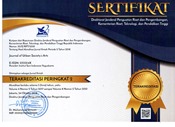Kapital dan Strategi Garin Nugroho dalam Proses Produksi Film
Abstract
Penelitian ini menganalisis struktur sosial Garin Nugroho sebagai sineas yang dilakukan berdasarkan paradigma sosial-kultural Pierre Bourdieu dengan pendekatan strukturalisme genetik. Teori strukturalisme genetik bertumpu pada empat konsep utama, yakni habitus, arena, kapital, dan strategi. Kajian ini diharapkan dapat melihat realitas sosial seorang sineas ketika memproduksi sebuah film. Data penelitian diperoleh dari dokumentasi media massa, katalog film, hasil wawancara narasumber, dan studi pustaka. Hasil penelitian menunjukkan bahwa terdapat dialektika internalisasi pada habitus Garin Nugroho yang menuntunnya untuk berani menutup luka lama kemudian membuka luka baru pada masa transisi budaya global. Dengan demikian, hubungan antara seni dan teknologi menjadi arena yang dipilih Garin Nugroho dalam memperjuangkan kreativitasnya. Dari arena perjuangan itu, ia memiliki beberapa jenis modal yang dipertukarkan dalam struktur sosialnya. Strategi yang diterapkan Garin Nugroho dalam menghadapi era digital adalah konsisten dalam menggunakan kecanggihan teknologi sebagai alat bantu untuk mewujudkan kreativitas melalui media film.
Capital and Garin Nugroho’s Strategy on the Process of Film Production. This study analyzes the social structure of Garin Nugroho as a filmmaker that has been conducted based on the socio-cultural paradigm of Pierre Bourdieu with the genetic structuralism approach. The genetic structuralism theory rests on four main concepts, namely habitus, arena, capital, and strategy. This study is expected to be able to see the social reality of a filmmaker when a film is produced. Data were obtained from the documentation of mass media, film catalogues, informant interviews, and literature. The results of this research show that there is a dialectic of internalization in Garin Nugroho’s habitus which leads him to dare to close the old wounds then opens the new ones in the transition period of global culture. Therefore, the relationship between art and technology has been a chosen field by Garin Nugroho in struggling for the creativity. From the field of the struggle, Garin Nugroho has some kind of capitals that are exchanged in the social stucture. The strategy that is applied by Garin Nugroho in facing the digital era is consitent in using the power of technology as a tool to realize any creativity throgh the media of film.
Keywords
Full Text:
PDFReferences
Binawan, Al. E. (2007). “Habitus Nyampah: Sebuah Refleksi”. Basis, Vol 56 No. 05/07 Mei
Bourdieu, P. (1990). The Logic of Practice. California: Atanford University Press.
Budiman, C. (2013). Retorik dan Makna Ideologis Karya Instalasi dalam Film Opera Jawa Garin Nugroho. RESITAL : JURNAL SENI PERTUNJUKAN, 14(1). doi:http://dx.doi.org/10.24821/resital.v14i1.390
Haryatmoko. (2010). Habitus dan Kapital Dalam Strategi Kekuasaan, teori strukturasi Pierre Bourdieu dengan Orientasi Budaya. Jakarta: Pasca Sarjana Sosiologi Universitas Indonesia.
Kristanto, J. B. (2005). Katalog Film Indonesia 1926-2005. Jakarta: Nalar.
Laksono, K; Purba, SA & Hapsari, PD. (2015). Musik Hip-Hop sebagai Bentuk Hybrid Culture dalam Tinjauan Estetika. RESITAL : JURNAL SENI PERTUNJUKAN, 16(2). doi:http://dx.doi.org/10.24821/resital.v16i2.1507
Prasetya, H. B., Haryono, T., & Simatupang, L. L. (2016). Habitus, Ngêng, dan Estetika Bunyi Mlèsèt dan Nggandhul pada Karawitan. Paradigma, Jurnal Kajian Budaya, 1(2), 152-167.
Ritzer, G., & Goodman J., D. (2003). Teori Sosiologi Modern. Jakarta: Prenada Media.
Tino, S. (2008). Dongeng Sebuah Produksi Film. Jakarta: Intisari Mediatama.
Web:
www.set-film.com diakses tanggal 17 November 2015.
www.filmindonesia.or.id diakses tanggal 17 November 2015.
www.youtobe.com : IFDC AWARDS 2014 _ Seri Diskusi_ Sutradara Film Indonesia Hari Ini (22 November 2014) diakses tanggal 10 November 2015.
DOI: https://doi.org/10.24821/jousa.v4i1.1492
Refbacks
- There are currently no refbacks.

This work is licensed under a Creative Commons Attribution 4.0 International License. ISSN 2355-2131 (print) | ISSN 2355-214X (online).






